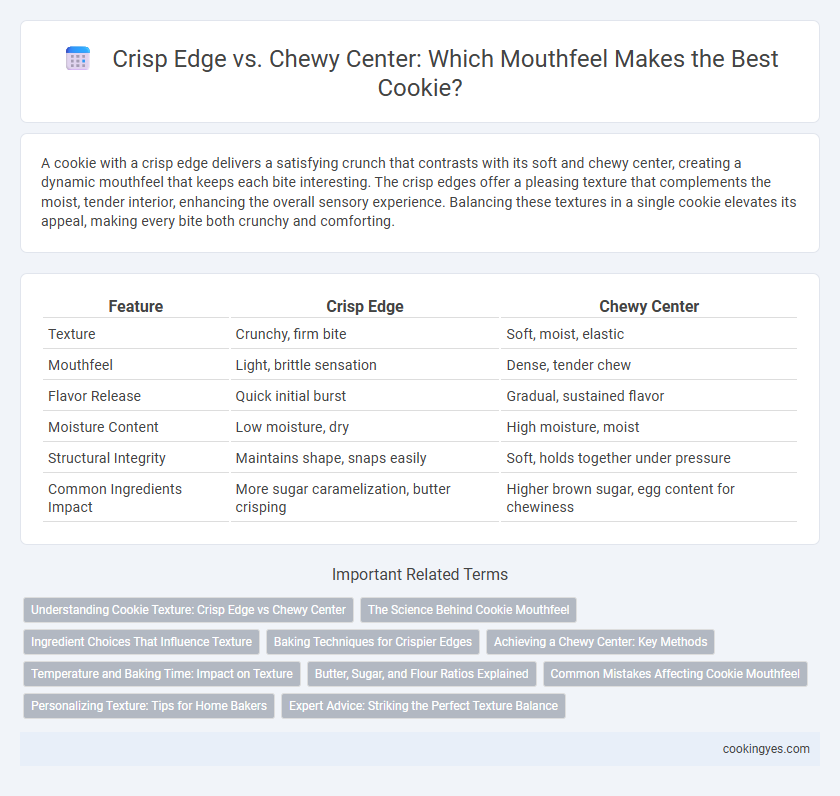A cookie with a crisp edge delivers a satisfying crunch that contrasts with its soft and chewy center, creating a dynamic mouthfeel that keeps each bite interesting. The crisp edges offer a pleasing texture that complements the moist, tender interior, enhancing the overall sensory experience. Balancing these textures in a single cookie elevates its appeal, making every bite both crunchy and comforting.
Table of Comparison
| Feature | Crisp Edge | Chewy Center |
|---|---|---|
| Texture | Crunchy, firm bite | Soft, moist, elastic |
| Mouthfeel | Light, brittle sensation | Dense, tender chew |
| Flavor Release | Quick initial burst | Gradual, sustained flavor |
| Moisture Content | Low moisture, dry | High moisture, moist |
| Structural Integrity | Maintains shape, snaps easily | Soft, holds together under pressure |
| Common Ingredients Impact | More sugar caramelization, butter crisping | Higher brown sugar, egg content for chewiness |
Understanding Cookie Texture: Crisp Edge vs Chewy Center
A crisp edge in cookies delivers a satisfying crunch due to higher sugar caramelization and longer baking, enhancing the contrast in texture. The chewy center retains moisture and provides a softer mouthfeel from underbaking or using ingredients like brown sugar and molasses. Balancing these elements creates the ideal cookie experience, combining crispness with a tender, chewy core.
The Science Behind Cookie Mouthfeel
The science behind cookie mouthfeel reveals how baking temperature and ingredient ratios influence texture, creating a crisp edge and chewy center contrast. Higher sugar content caramelizes at the edges, forming a firm, brittle exterior, while moisture retention in the center maintains softness and chewiness. Precise control of flour type, butter temperature, and baking time enables the distinct mouthfeel dynamics cherished in optimal cookie recipes.
Ingredient Choices That Influence Texture
High butter content and soft brown sugar contribute to a crisp cookie edge by promoting caramelization and moisture evaporation, while higher moisture ingredients like molasses and eggs enhance chewiness in the center. Incorporating bread flour or higher protein flours strengthens gluten formation, resulting in a chewier texture, whereas lower protein flours and cornstarch favor a tender, crisp bite. Adjusting leavening agents such as baking soda encourages spreading and a thinner edge, contrasting with baking powder's role in producing a puffier, softer center.
Baking Techniques for Crispier Edges
Baking techniques for crispier cookie edges involve using higher oven temperatures and spreading the dough thinner to promote faster caramelization, which creates a crunchier texture. Incorporating ingredients like granulated sugar instead of brown sugar enhances crispness by reducing moisture retention in the edges. Chilling the dough before baking also helps control spreading, resulting in a distinct contrast between crisp edges and a chewy center.
Achieving a Chewy Center: Key Methods
Achieving a chewy center in cookies relies on precise control of moisture content and ingredient ratios, with higher brown sugar levels enhancing chewiness due to its hygroscopic nature. Incorporating bread flour increases gluten development, providing a dense, elastic texture that contributes to a soft, chewy middle. Adjusting baking time and temperature, such as slightly underbaking at lower temperatures, preserves internal moisture, resulting in a tender, chewy core.
Temperature and Baking Time: Impact on Texture
Baking temperature and time critically influence the contrast between a crisp edge and a chewy center in cookies. Higher temperatures with shorter baking times typically yield crispy edges while preserving a soft, chewy center by setting the exterior quickly without over-drying the interior. Conversely, lower temperatures and longer baking durations produce a more uniform texture, reducing the distinctive crisp-chewy balance sought in optimal cookie mouthfeel.
Butter, Sugar, and Flour Ratios Explained
A crisp cookie edge results from higher butter and sugar ratios, where butter's fat content promotes browning and sugar caramelization that create a crunchy texture. Chewy centers rely on increased flour and moisture retention, with more flour absorbing liquid to produce a dense, soft bite. Balancing these ingredients adjusts cookie structure, controlling the contrast between crispness and chewiness for ideal mouthfeel.
Common Mistakes Affecting Cookie Mouthfeel
Common mistakes affecting cookie mouthfeel include overbaking, which causes the edges to become excessively crisp while leaving the center dry rather than chewy. Using too much flour or insufficient fat can result in a tough texture instead of a tender, chewy interior. Failing to balance sugar types, such as brown sugar for moisture and white sugar for crispness, often leads to inconsistent mouthfeel between the cookie's edges and center.
Personalizing Texture: Tips for Home Bakers
Personalizing cookie texture involves balancing the crisp edge with a chewy center by adjusting ingredient ratios and baking times. Using higher brown sugar content increases moisture retention for a chewy middle, while butter for crispness enhances golden, crunchy edges. Home bakers achieve ideal mouthfeel by chilling dough, flattening cookies before baking, and experimenting with baking temperature to fine-tune texture preferences.
Expert Advice: Striking the Perfect Texture Balance
Achieving the ideal cookie mouthfeel requires balancing a crisp edge with a chewy center, a hallmark of expert baking. Precise control of baking time and temperature ensures the edges caramelize and crisp while the center retains moisture and softness. Ingredient ratios, particularly the use of brown sugar and butter, play a crucial role in creating this textural contrast, delivering a satisfying bite that pleases both texture-conscious bakers and cookie lovers.
Crisp edge vs Chewy center for mouthfeel Infographic

 cookingyes.com
cookingyes.com